To test drive a car, you need to be at least 18 years old. The minimum age requirement for test driving a car is 18 years.
When considering purchasing a new vehicle, it’s crucial to have a firsthand experience behind the wheel. Test driving allows potential buyers to evaluate a car’s features, performance, and overall suitability. However, there are regulations in place regarding the age at which one can test drive a vehicle.
In most countries, including the United States, the minimum age requirement for test driving a car is 18 years. This age restriction ensures that individuals possess a valid driver’s license and adequate driving experience. By adhering to this requirement, dealerships can maintain safety standards and protect their vehicles from potential mishaps or accidents during test drives.

Credit: www.mercedesbenzofeaston.com
Laws And Regulations
When it comes to test driving a car, there are laws and regulations in place to ensure safety and compliance. It’s important to understand the minimum age requirement and the requirements for accompanying adults when it comes to test driving a car.
Minimum Age Requirement
In most states, the minimum age requirement to test drive a car is 18. This is due to legal liability issues and the fact that individuals under 18 are not considered adults by law.
Requirements For Accompanying Adults
For those under 18, it’s essential to have a parent or legal guardian accompany them during a test drive. This adult must take legal responsibility for any damages or issues that occur during the test drive.

Credit: freemius.com
Dealer Policies
The dealer policies regarding age restrictions for test driving a car can vary from dealership to dealership. It is important to understand these policies before attempting to test drive a vehicle.
Age Restrictions Set By Dealerships
Dealerships have their own specific age restrictions when it comes to test driving a car. While some may allow individuals as young as 16 to test drive a vehicle, others may require drivers to be at least 18 or even 21 years old. It is crucial to contact the dealership you are interested in visiting to inquire about their specific age requirements.
Permission From Legal Guardian
If you are under the age of 18, dealerships may require permission from your legal guardian in order for you to test drive a car. This is an important step to ensure your safety and the dealership’s liability. Make sure to check with the dealership if this is a requirement, and if so, bring your legal guardian along with you to provide consent.
Insurance Considerations
When it comes to test driving a car, there are several insurance considerations that you should keep in mind. Understanding the age-related insurance premiums and coverage options for underage drivers can help you make an informed decision. Let’s explore these aspects in more detail below.
Age-related Insurance Premiums
Insurance premiums, the amount you pay for coverage, are often determined by your age. For new drivers who are just starting out, insurance companies consider them as higher risk than experienced drivers. As a result, their premiums may be higher. However, with each passing year of safe driving, these premiums tend to decrease.
It’s important to remember that insurance premiums vary from one insurance provider to another. Some insurance companies may have specific age thresholds where they offer lower premiums, so it’s always a good idea to compare quotes from different insurers. This can help you find the most affordable coverage while adhering to the legal requirements for test driving a car.
Coverage For Underage Drivers
When it comes to underage drivers, there are a few key considerations for insurance coverage. Typically, drivers under the age of 18 are considered minors and may require their parent or legal guardian to be listed on their insurance policy. This arrangement ensures that the responsible adult is also financially protected in case of any accidents or damages caused during the test drive.
Moreover, insurance companies may have specific restrictions or requirements for underage drivers. For example, some insurers may require the completion of a defensive driving course or limit the driving hours for underage drivers. Make sure to check with your insurance provider to understand their specific guidelines and any additional coverage options they may offer for underage drivers.
Lastly, it’s crucial to note that insurance coverage for test drives may differ from regular insurance policies. Some car dealerships or manufacturers may provide temporary insurance coverage for test drives, offering protection during the specified time frame. However, it’s always best to consult with your insurance provider to ensure that you have adequate coverage during the test drive.
In conclusion, understanding the age-related insurance premiums and coverage options for underage drivers is crucial when it comes to test driving a car. By exploring the specific guidelines of your insurance provider and comparing quotes, you can find the right coverage that not only protects you but also meets the legal requirements for test driving.
Safety Measures
When it comes to test driving a car, safety measures are a top priority to ensure a secure and controlled experience for everyone involved. From supervision during the test drives to specific safety features and restrictions, these measures play a crucial role in determining the age at which individuals can partake in this activity.
Supervision During Test Drives
- Young drivers typically need to be accompanied by a licensed adult who can oversee the test drive.
- Having an experienced driver present ensures that proper guidance and instruction are provided during the drive.
Safety Features And Restrictions
- The vehicle used for the test drive must be equipped with passenger-side brakes for the supervising driver to intervene if necessary.
- Restrictions often apply to speed limits and specific driving routes during test drives, enhancing safety for the participants.
- Seat belt usage is mandatory during the test drive, with a zero-tolerance policy for non-compliance to ensure everyone’s safety.
Parental Guidance
Parental Guidance: It’s essential for parents to be actively involved in their child’s car test driving process.
Involvement In The Process
Parents should accompany their child during test drives for guidance and support.
Educating Young Drivers
Teaching young drivers road safety rules and proper handling of the vehicle is crucial.

Credit: datamyte.com
Alternative Options
Young drivers who are not yet of legal driving age still have ways to experience a test drive. Alternative options like virtual test drives and simulation programs provide valuable insights and help individuals gain a sense of what it’s like to be behind the wheel. Here’s a look at these exciting opportunities:
Virtual Test Drives
Virtual test drives utilize advanced technology to give users a realistic driving experience without leaving the comfort of their homes. Through the use of VR headsets and interactive software, individuals can explore different car models and navigate simulated road conditions as if they were actually driving.
Simulation Programs
Simulation programs offer aspiring drivers the chance to practice their skills in a controlled environment. These programs often feature realistic driving scenarios and challenges that allow users to enhance their driving abilities and build confidence before hitting the road.
Risk Assessment
When it comes to test driving a car, a critical aspect that needs to be considered is the risk assessment. Evaluating the age at which an individual can test drive a car includes a thorough assessment of maturity levels and recognition of potential dangers related to underage test driving.
Evaluation Of Maturity Levels
The evaluation of an individual’s maturity level is crucial in determining their eligibility for test driving a car. This assessment encompasses not just the individual’s age, but also their ability to make sound decisions, exhibit responsibility, and adhere to safety protocols.
Potential Dangers Of Underage Test Driving
Allowing underage individuals to test drive cars poses potential dangers that cannot be overlooked. These risks include lack of experience, immature decision-making, and inadequate understanding of traffic regulations, which could lead to accidents and injuries.
Experiential Learning
Experiential learning is an invaluable way for individuals to gain practical knowledge and skills through hands-on experiences. When it comes to driving, this type of learning is crucial in developing safe and responsible habits behind the wheel. Testing driving a car allows young drivers to familiarize themselves with the vehicle’s functions, road etiquette, and traffic laws. In this article, we will discuss the importance of gaining driving experience and the benefits of early exposure to driving.
The Importance Of Gaining Driving Experience
Driving experience, acquired through real-world practice, is essential for becoming a confident and responsible driver. It provides an opportunity to apply theoretical knowledge and develop practical skills that cannot be fully grasped by simply reading a book or studying driving rules. Gaining driving experience allows individuals to:
- Become familiar with different road conditions and environments.
- Learn how to handle various traffic situations and make split-second decisions.
- Develop good judgment and spatial awareness.
- Understand the importance of defensive driving and anticipating potential hazards.
- Improve their coordination, reflexes, and overall control of the vehicle.
Without practical experience behind the wheel, it is difficult to fully comprehend the complexities and challenges of driving. By gaining driving experience at an appropriate age, individuals can significantly enhance their abilities and build a solid foundation for safe driving throughout their lives.
Benefits Of Early Exposure To Driving
Early exposure to driving, while under appropriate supervision, can provide numerous benefits for young individuals. Here are some advantages of getting behind the wheel at a younger age:
- Increased familiarity with cars: Being exposed to the mechanics and controls of a vehicle from a young age can help young drivers become comfortable with the basics of operating a car. This familiarity reduces anxiety and creates a smoother transition to independent driving later on.
- Improved decision-making skills: Experiencing real-time traffic situations and decision-making scenarios at an early age helps young drivers develop critical thinking skills. This early exposure allows them to understand the consequences of their actions, learn from mistakes, and make better judgments on the road.
- Enhanced risk perception: Early exposure to driving allows young individuals to recognize and assess potential risks on the road more effectively. With time, they develop a sharper sense of situational awareness, enabling them to anticipate and avoid dangerous situations.
- More time for practice: Starting driving at a younger age provides more time to accumulate driving hours and practice essential skills. Practice plays a vital role in building confidence and proficiency on the road.
It’s important to note that while early exposure to driving can have its benefits, it should always be accompanied by proper supervision and adherence to legal requirements. Safety should be the top priority for young drivers, and they must follow age restrictions and any other guidelines set by their local authorities.
Conclusion
The legal age for test driving a car varies by state. It’s important to check the specific regulations in your area. Remember, safety should always be a priority when allowing young drivers to test drive. Understanding the age requirements can help ensure a smooth and legal test driving experience.


